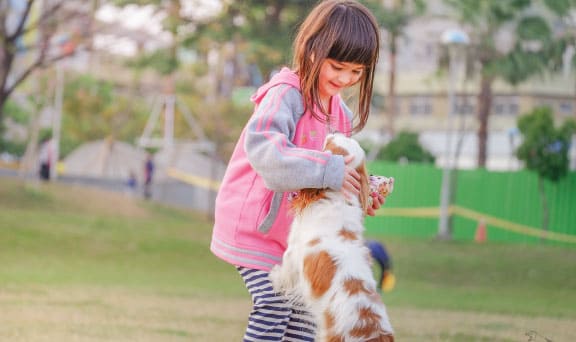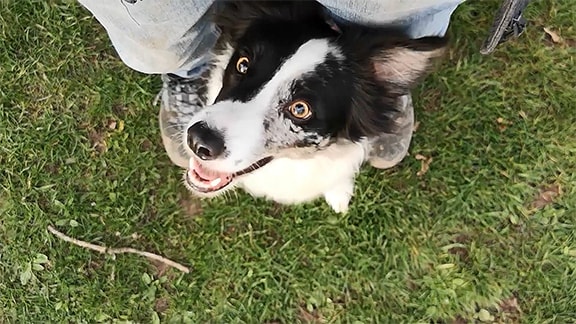Dogs: The World’s Most Exciting Teddy Bear
There have been some devastating incidents between dogs and children in the media recently, and as parents, dog owners and dog professionals it’s deeply saddening and scary to be reminded of the reality of what can happen when we get this precious relationship between humans and canines so wrong.
Most of us began our love and fascination with dogs as children. Spotting them out and about on their walks, or tied up outside the corner shop. Maybe you were lucky enough to have one as a pet.

Children are naturally curious creatures and let’s be honest, dogs are pretty amazing. Even as adults it’s hard enough to muster enough self control to not greet cute puppies in the street. As children with limited impulse control and ten times the energy, it’s easy to see why they have a hard time leaving dogs be.
They are often confronted with ‘don’t’ and ‘no’ at every turn.
Don’t pull on Roxy’s ears like that. No you can’t hold Charlie’s lead. Don’t make so much noise by Reggie. Leave Lola alone. Stop this. Stop that.
There are lots of guides and advice on what kind of things you shouldn’t allow your children to do to or around dogs. They absolutely need to know those things and have clear boundaries around dogs, as well as appropriate supervision.
You should definitely follow that guidance and educate them as to what not to do, and also explain to them why.
However, just like with our dogs, we should also set our children up for success around dogs. By giving them a clear understanding of what they can do! Praise them, yes, Buddy likes you doing that. That way they know what is good and are more likely to do that in the future.
What does a great interaction between your dog and child look like, or your dog and a family friend or even a strangers child. Children love to interact with dogs, so give them a way of doing it that works for you and your dog.
Dog Spotting
Observing dogs is a great way to engage children in dogs positively, especially for young children who would struggle to understand instructions for up close interaction.
How many legs does a dog have? What colour fur does it have? Does it have spots? Do its ears stick up or flop down?
You can even begin teaching some basic canine body language. That doggy doesn’t look too happy, see how its ears are back and tail is tucked down.
This is perfect for dogs that you don’t know or ones that you do know that wouldn’t like any closer contact.
Double Lead
‘Can I hold the lead?’
Children love to hold the lead when walking the dog, especially if it’s their new family member.
It’s not always safe to hand the lead over to them but a great solution is to clip on a second lead for them to hold. That way you always have control too.
It’s a great training opportunity for your dog too, can they still walk nicely on the lead when there’s a different scenario? You may have to reward them to help them practice in this new situation.
Pet them like this
Instead of don’t, do! Children inevitably will want to touch dogs, it’s how they learn, process sensory information and let’s face it, a dog, to a child is the equivalent of the world’s most exciting teddy bear.
Many dogs do like to be fussed and have attention, it is important though that its how they actually like it. This can be something adults get wrong with our dogs, let alone children. So let’s give them clear instructions on the best way for our dogs.
Stroke him by here, he likes that.
He likes it when you are gentle, just like that.
Great job!
It’s raining treats!
Watching a dog eat a scooby snack is a joy to behold for most children, and the dogs quite like it too!
Children can give a dog a treat for nice calm behaviour, great reinforcement for your dog.
A treat can be rolled across the floor for the dog to chase.
If your dog is less keen on children and needs a bit more space you can have the child hide a few treats around the room and then sit up on a chair out of the way and watch the dog sniff them out!
Training Classes
Where better for children to learn how to interact with their dog than at a child-friendly dog training class!
At Boomerang Dogs all of our classes are child-friendly. In fact we encourage the whole family to come and get involved in playing games and training the family dog.
Some of our young handlers take the lead, literally and figuratively, at the classes doing all of the training themselves! It’s amazing to see such great relationships flourishing and such responsible dog ownership in action.
Children are the dog owners and enthusiasts of the future!
We have a duty to foster healthy and positive relationships between children and dogs, so that the future is brighter, and safer for both dogs, and children alike.
Do you have children and a dog? We’d love to hear your experiences in the comments below!
Don’t hesitate to get in touch if you need advice on how to create a safe and positive relationship for your dog with children.
6 Reasons You Would Be Crazy to Not Teach Your Dog ‘Middle’!
Middle is one of the most useful things that you can teach your dog. It is getting your dog to stand in between your legs, and even move around with you as you walk if you practice!
At first it seems like a really cool trick – and yes, it totally is. However it is also so much more than that! Middle has so many uses and once you start using it yourself, you will find you start to call on it all the time.

Here are just 6 of our favourite reasons you should teach your dog a middle today:
1. Relaxed Vet Visits
It’s inevitable that at some point you will end up at the vets with your dog – maybe you need a routine check up or it is time for vaccinations, or heaven forbid they’ve had an accident.
Middle is a calm, relaxed place to chill out while waiting for your turn without getting them stressed out and over aroused. Middle is the perfect position to put your pooch in to stop them wandering all over the vet practice, trying to greet that grumpy cat in a basket or slip sliding around the shiney floor like Bambi on ice while you are waiting to be called in.
This is not even the best bit, where Middle really shines at the vets is when it’s time for the examination..
Being handled by a new person in a strange outfit can be stressful and it’s can be so easy for dogs to build a negative association with the vets because generally we only go there when something is wrong, or when our dogs are already feeling poorly.
You can use Middle as your superpower, allowing you to get your dog into a position where they are close to you for reassurance and you can feed them to help with calmness.
In turn you will find you can build a positive association and detect quickly if your dog has hit their threshold and no longer takes food.
It also allows the vet to be able to perform an examination safely and deliver vaccinations while you keep your dog focused or for nail care, whether that’s by your vet nurse, groomer or yourself.
Give it a try, you’ll be amazed!
2. Relationship Building
A middle for a dog is like a person holding someone’s hand. It can make them feel safe and connected to you. It allows them to communicate with you, that they are perhaps worried or concerned, not feeling entirely secure or even that they just want to be close to you and have fun.
How amazing is that! Giving your dog a channel to talk to you and share how they are feeling, their wants and needs. It’s the ultimate relationship booster.
3. Reliable Recall
As your dog builds lots of value in being in Middle it will become their favourite place to be. Given the chance they will never miss out on an opportunity to play Middle.
This is incredibly useful as part of your recall games. Recall is its strongest when your dog thinks the fun is always with you and Middle is a party they will love.
It’s also the perfect position for them to be in for you to put their lead on their collar. Win, win!
4. Managing Tricky Situations
Middle is amazing for managing dogs that are nervous or reactive to other dog, people or vehicles. It enables you to take away their line of sight of the thing they are nervous of, and gives them something positive to focus on instead. Once you get really good at it you will even be able to walk away from the situation in middle!
It’s a beautiful, sunny day and you are out with your pup. Suddenly you spot a squirrel in the distance and you know any minute your dog will spot it and turn into an unstoppable squirrel-chasing machine.
Or you calmly call them to a middle position, spin around to face a different direction and they don’t get the opportunity to even see it. For them, it’s a great game and are none the wiser and you averted a Fenton rerun and all is good in the world.
5. Perfect Portable Boundary
Boundaries can be really useful out and about. You can use it to stop and have a chat with a friend, take an important phone call or waiting for other people and dogs to pass by. What if there is nothing around in the environment to use though? Middle saves the day!
Boundaries are the same as bed and mat training, teaching your dog to settle and be calm in a set space. We instead call it a boundary so that we can be creative with what we use! Sofas, tree stumps, drain covers, the possibilities of what can be a boundary are limitless.
Your dog can sit in middle or even lie down, that way you can focus on what you need for 5 minutes and be aware of where your dog is and what they are doing.
6. Top Training Tool
It’s great to kick off your training sessions with some easy wins for your dog. Middle is perfect for this, it sets the tone for your training by being fun and warming up their brain ready to work.
You can also pop your dog into a middle to give you time to think about your next steps in the training session without them wandering off.
Middle is the foundation of many other behaviours too! You can use it to teach a range of awesome tricks, a base for fitness and stretching or as a startline wait in sports.
How to teach a Middle
- Take a treat in both hands
- With one hand lure your dog behind your leg
- With the other hand use the treat to lure them through so that they are standing between your legs
- Feed them a few treats in a row while they are there
- Throw a treat out in front of you and say ‘OK’ to release them
- Rinse and repeat